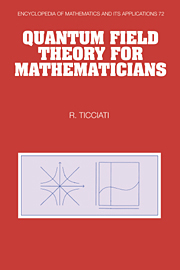Book contents
- Frontmatter
- Contents
- Preface
- Introduction
- 1 Relativistic Quantum Mechanics
- 2 Fock Space, the Scalar Field, and Canonical Quantization
- 3 Symmetries and Conservation Laws
- 4 From Dyson's Formula to Feynman Rules
- 5 Differential Transition Probabilities and Predictions
- 6 Representations of the Lorentz Group
- 7 Two-Component Spinor Fields
- 8 Four-Component Spinor Fields
- 9 Vector Fields and Gauge Invariance
- 10 Reformulating Scattering Theory
- 11 Functional Integral Quantization
- 12 Quantization of Gauge Theories
- 13 Anomalies and Vacua in Gauge Theories
- 14 SU(3) Representation Theory
- 15 The Structure of the Standard Model
- 16 Hadrons, Flavor Symmetry, and Nucleon-Pion Interactions
- 17 Tree-Level Applications of the Standard Model
- 18 Regularization and Renormalization
- 19 Renormalization of QED: Three Primitive Divergences
- 20 Renormalization and Preservation of Symmetries
- 21 The Renormalization Group Equations
- Appendix
- References
- Index
9 - Vector Fields and Gauge Invariance
Published online by Cambridge University Press: 31 October 2009
- Frontmatter
- Contents
- Preface
- Introduction
- 1 Relativistic Quantum Mechanics
- 2 Fock Space, the Scalar Field, and Canonical Quantization
- 3 Symmetries and Conservation Laws
- 4 From Dyson's Formula to Feynman Rules
- 5 Differential Transition Probabilities and Predictions
- 6 Representations of the Lorentz Group
- 7 Two-Component Spinor Fields
- 8 Four-Component Spinor Fields
- 9 Vector Fields and Gauge Invariance
- 10 Reformulating Scattering Theory
- 11 Functional Integral Quantization
- 12 Quantization of Gauge Theories
- 13 Anomalies and Vacua in Gauge Theories
- 14 SU(3) Representation Theory
- 15 The Structure of the Standard Model
- 16 Hadrons, Flavor Symmetry, and Nucleon-Pion Interactions
- 17 Tree-Level Applications of the Standard Model
- 18 Regularization and Renormalization
- 19 Renormalization of QED: Three Primitive Divergences
- 20 Renormalization and Preservation of Symmetries
- 21 The Renormalization Group Equations
- Appendix
- References
- Index
Summary
Presenting the canonical quantization of a massive vector field, the existence of a massless limit when this field is coupled to a conserved current, and the gauge invariance of this massless limit; a preliminary understanding of QED.
Introduction
Now that we have found fermionic fields, the need is for polarized fields that can represent the photon. Experimentally, photons have only the two transverse polarizations and no possibility of polarization along the direction of motion. Since these polarizations are vectors in Minkowski space, we shall begin our investigation using a vector field, a set of four hermitian fields Aμ that transform as a vector under the Lorentz-group action on the fields.
The most general Lagrangian density for a free vector field contains two free parameters, a and b. After careful analysis of this Lagrangian density, we find in Section 9.1 that the classical theory is only free from off-shell modes and modes with longitudinal polarizations when a = -1 and b ≠ 0, in which case the vector field is massive. We also observe that when a = -1 and b = 0, the vector field is massless and has a gauge symmetry which makes the longitudinal modes non-physical.
Rather than set up the functional integral machinery necessary for quantizing the gauge field theory, in this chapter we treat the gauge theory as the massless limit of a massive vector field theory.
- Type
- Chapter
- Information
- Quantum Field Theory for Mathematicians , pp. 246 - 268Publisher: Cambridge University PressPrint publication year: 1999



